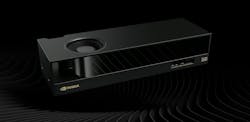Workstation GPGPU Ramps Up AI Performance for Content Creators
What you’ll learn:
- How the RTX Pro series targets content creators.
- Performance improvements of the RTX Pro series.
Unlike NVIDIA’s H200 GPGPU that targets cloud servers, the RTX Pro series includes display outputs and targets workstations for content creators as well as AI developers. The company's RTX Pro 4000 Blackwell SFF Edition (see figure) and the RTX Pro 2000 Blackwell GPGPU are the latest to be designed for high-performance workstations. They provide sufficient performance to run artificial-intelligence (AI) models as well as display graphics so that creators can see the results.
The two boards need 70 W of power — the RTX Pro 4000 Blackwell SFF Edition delivers 770 AI TOPS (FP4 with sparsity support) versus 545 AI TOPS for the 2000. This is partly due to the 24 GB of GDDR7 with error correction code (ECC) support running at 432 GB/s, plus 8,960 CUDA cores versus 16 GB and 288-GB/s bandwidth running on 4,352 CUDA cores. Both boards employ NVIDIA’s Blackwell Streaming Multiprocessor (SM) architecture that supports programmable neural shader cores.
The PCI Express Gen 5 boards have four Mini DisplayPort 2.1b connections. They both incorporate NVIDIA 5th-Gen Tensor Cores with FP4 precision support and DLSS 4 Multi Frame Generation, as well as 4th-Gen Ray Tracing Cores. Both also support 9th-Gen NVIDIA encoders (NVENCs) and 6th-Gen NVIDIA Decoders (NVDECs) with 4:2:2 support. Compared to its predecessor, the RTX Pro 4000 ups AI performance by a factor of 2.5 and ray-tracing performance by a factor of 1.7.
The RTX Pro series targets a range of developers, from those using computer-aided-design (CAD) tools to image and video content creators that take advantage of AI tools. The boards can also support software developers using frameworks like the company’s Cosmos platform, which works with digital twins and physical AI, also called robots. Cosmos-Reason1-7B models can run locally on the RTX PRO 4000 SFF without having to resort to the cloud.
In addition, the NVIDIA Isaac Sim simulation environment can handle autonomous vehicles (AVs) and other types of robots as well as video-analytics AI agents.
Developers may use pretrained multimodal generative models on the RTX Pro series. The platforms also support post-training to develop specialized physical AI models. Cosmos Reason handles vision language models (VLMs) that can analyze the simulated or physical world from videos and images.
About the Author
William G. Wong
Senior Content Director - Electronic Design and Microwaves & RF
I am Editor of Electronic Design focusing on embedded, software, and systems. As Senior Content Director, I also manage Microwaves & RF and I work with a great team of editors to provide engineers, programmers, developers and technical managers with interesting and useful articles and videos on a regular basis. Check out our free newsletters to see the latest content.
You can send press releases for new products for possible coverage on the website. I am also interested in receiving contributed articles for publishing on our website. Use our template and send to me along with a signed release form.
Check out my blog, AltEmbedded on Electronic Design, as well as his latest articles on this site that are listed below.
You can visit my social media via these links:
- AltEmbedded on Electronic Design
- Bill Wong on Facebook
- @AltEmbedded on Twitter
- Bill Wong on LinkedIn
I earned a Bachelor of Electrical Engineering at the Georgia Institute of Technology and a Masters in Computer Science from Rutgers University. I still do a bit of programming using everything from C and C++ to Rust and Ada/SPARK. I do a bit of PHP programming for Drupal websites. I have posted a few Drupal modules.
I still get a hand on software and electronic hardware. Some of this can be found on our Kit Close-Up video series. You can also see me on many of our TechXchange Talk videos. I am interested in a range of projects from robotics to artificial intelligence.


